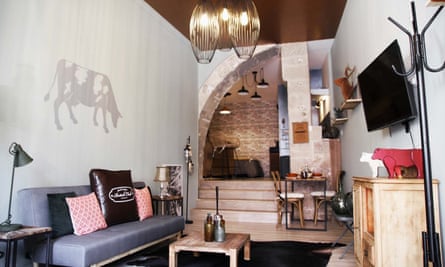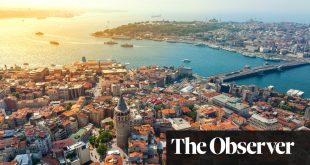It’s certainly an eye-catching shop window, full of interesting artefacts – an old sewing machine stands poised over a sheet of leather, with an oil lamp on one side, ancient shoe moulds on the other. There’s more leather hanging above, with footsteps cut into it. I step into the Tannerie, then lock the door behind me.
I’m not here to shop, but to sleep in the appealing apartment inside it, with an inviting living room leading up several steps to comfortable sleeping quarters. A kitchenette and a swish modern shower room complete the picture. It’s spacious, tastefully decorated and better than many hotel rooms – yet a fraction of the price, at €75 a night.
One of half a dozen former shop premises which have been given a new lease of life, the Tannerie is part of a new scheme called BedinShop, aimed at regenerating the medieval town centre of Romans-sur-Isère, about 90 minutes south of Lyon in France’s Drôme department. They include a bookshop, a tailor’s and a laundry, but the Tannerie is particularly significant: this town of 33,000 inhabitants was once the capital of luxury shoemaking in France. Charles Jourdan – who partnered with Christian Dior – and Stephane Kélian – who worked with Jean-Paul Gaultier – were among the town’s factory owners.

When production moved to less-expensive parts of the world and out-of-town supermarkets attracted business away from the historic centre, much of Romans-sur-Isère literally shut up shop. The situation prompted BedinShop founder François-Xavier Chambost to act. “I was walking along streets that had been buzzing with shoppers when I was a child, and I saw young people fighting, piles of old wooden pallets and empty shops,” he says. “I wondered if the youths could be taught to make furniture from the pallets that we could then use in shops converted to overnight accommodation.”
A walnut trader at the time, he got the town hall and social workers on side, gained invaluable business knowhow through French organisation Villages Vivants (living villages), and convinced local landlords to invest in their properties in return for guaranteed rent. His first venture, the Bouquiniste (Bookseller), opened in April 2019 in a shop that had been vacant for 15 years; the sixth, L’Apothicaire, opens soon.
They’re all beautifully decorated. It helps that Francois-Xavier’s wife, Cynthia, is an interior designer. “I try to give a soul to each one and reflect it subtly in the interior,” she says. Using a mix of upcycled charity shop finds, donations and some serious creativity, she has worked her magic in the apartments, incorporating original features such as exposed stone, vaulted ceilings and archways.

There are fun details throughout, with an old Singer sewing machine fashioned into furniture at Le Tailleur (the Tailor) and lamps secreted in books in the two-bedroom Bouquiniste, whose window display incorporates ancient tomes. “I’ve heard people standing outside wondering when it’s going to open so they can buy one,” says Francois-Xavier. Everywhere, old shutters or wooden crates double as shelves; sinks might be made from a traditional iron washing basin; furniture pallets are fashioned into coffee tables, cupboard doors and bedheads. They were made by local youths, some of whom also give tours of the town in return for a small tip; both the financial incentive and learning to create something that “helps keep them out of trouble and gives them pride in their town,” says social worker Loïc Chasson.
With its 11 centuries of history, Romans is a town to be proud of, and makes a great base for exploring the surrounding villages and the town of Valence, seven minutes away by train. Exploring the compact centre on foot won’t wear out too much shoe leather. Some alleyways are so narrow I can see the indent worn by carriage wheels in the walls, and specialist shops include a luxury fan artisan and a violin maker in Rue Pêcherie. The church of St Bernard has Romanesque and Gothic architecture, geometric medieval wall paintings and is in a beautiful position by the Isère river, with its 11th-century bridge and the Vercors mountains in the distance. A five-minute walk up the hill, the 12th-century Jacquemart tower is the only part of the medieval walls that remain; it’s now a clock tower presided over by a bell-striking automaton.
Reminders of Romans’ shoemaking past are everywhere, from the old tanners’ houses in the Quartier de la Presle to the 11 massive shoe statues dotted around town, starting with a huge red one outside the train station. I follow the hour-long shoe trail, taking in giraffe-motif footwear by a roundabout, a Louboutin in front of the pharmacy and a red-spotted pump by the Shoe Museum, set in an old convent.
Inside, I’m entranced by the enormous collection of footwear through the ages, including horrifically tiny shoes for Chinesewomen with bound feet, as well as enough modern-day heels to make Carrie Bradshaw swoon. For modern-day shoe fans, Cité de la Chaussure in the town centre has a tempting selection of handmade leather footwear from €49. The factory workshop was opened in 2019 by a group who wanted to revive Romans’ shoe-making tradition while helping the unemployed return to work.

Just steps away I discover the Cité de la Raviole – it turns out that Romans and the surrounding region is also famous for its cheese-filled pasta, whose origins can be traced to 16th-century Italian lumberjacks working in France. After finding out more about the pasta, where they sell it filled with everything from truffles to Valrhona chocolate, I tuck into a plateful in La Raviolista restaurant.
It’s good, but my favourite restaurant in Romans is Magma Terra, whose vegetable-leaning fine food can be matched with a flight of organic wine or beer. Better still, it’s just steps from the Tannerie, with its cowhide rugs, shoe-last towel hangers and a bed headboard decorated with the leather offcuts. And as I shut up shop for the last time by pulling down the blinds behind the double shop window, I can’t believe how quiet and private this town-centre dwelling feels.
Accommodation was provided by BedinShop, which has apartments for two from €70 a night. Train travel was provided by Trainline, which has fares via Paris to Romans-Bourg-de-Péage from £186 return
 Top Naija News: Nigerian News, Breaking News Nigeria and World News Top Naija News is a daily news publication in Nigeria, delivering the latest breaking news in Nigeria and around the world.
Top Naija News: Nigerian News, Breaking News Nigeria and World News Top Naija News is a daily news publication in Nigeria, delivering the latest breaking news in Nigeria and around the world.



